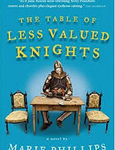 The Round Table was round for a reason: all its knights shared equal billing, and hence precedence (even though, these days, most of us can’t name more than one or two). In her hilarious take on the Arthurian legend, “The Table of Less Valued Knights,” Marie Phillips posits two additional tables, the Table of Errant Companions (oval, for knights aspiring to the Round Table) and the Table of Less Valued Knights (rectangular, with one leg shorter than the others). “It was home to the elderly, the infirm, the cowardly, the incompetent, and the disgraced. . .” says Phillips. The hierarchy is clear.
The Round Table was round for a reason: all its knights shared equal billing, and hence precedence (even though, these days, most of us can’t name more than one or two). In her hilarious take on the Arthurian legend, “The Table of Less Valued Knights,” Marie Phillips posits two additional tables, the Table of Errant Companions (oval, for knights aspiring to the Round Table) and the Table of Less Valued Knights (rectangular, with one leg shorter than the others). “It was home to the elderly, the infirm, the cowardly, the incompetent, and the disgraced. . .” says Phillips. The hierarchy is clear.
The novel opens on Pentecost night, when the knights gather to repeat their vows, celebrate the past year, and await the most prestigious new quest. Edwin enters the room in search of a champion, stating he is King (or prince consort) of a neighboring kingdom, and his wife, Martha, has been kidnapped on their wedding night. A knight duly heads off with Edwin – since Edwin is clearly not Round Table material he’s not interested in doing the job on his own. Sir Humphrey from, yes, the Table of Less Valued Knights lingers in the hall, and is still there and available when a second seeker, Elaine, arrives. She, too, needs a knight, as her fiance has been abducted by a knight wearing black armor just before their wedding.
We learn fairly quickly that Martha, rather than consummate her marriage to the bombastic and annoying Edwin, has run away. The local Crone, Martha’s first choice for help, is unfortunately unavailable, but she has left an Acting Crone in her place. The Acting Crone is young and inexperienced. Instead of changing Martha into a man she manages to change only Martha’s appearance, giving her a scruffy beard but leaving the gender-identifying and eliminatory organs intact. (If you’re worried, the Acting Crone gives Martha a tiny bottle of universal panacea for later.) Martha looks like a 14-year-old male version of herself. Since she’s a very innocent young woman, she acts like a 14-year-old female version of herself. There are a lot of opportunities for entertainment here, and Phillips takes them, especially after Martha acquires a sword (from the Lady of the Lake, of course) (not really, it was the Lady’s Locum) and joins forces with Humphrey and Elaine. And Humphrey’s squire, a half-giant named Conrad, and their livestock, which includes an elephant named Jemima. Though joins forces only partly describes the complicated relationship, as Martha is partially their prisoner (her sword, which appears to have a mind of its own, attacked Humphrey).
Martha, who has told the others her name is Marcus, keeps forgetting she’s a boy, which leads to all kinds of awkwardness. Phillips has a good time playing with the cultural expectations we have now based on appearance, and the juxtaposition of our assumptions with the Code of Chivalry. The writing is clear, focused, and consistently entertaining. Here’s one example, where Conrad, who is very angry with Humphrey, thinks of all the ways Humphrey violates the code he claims to live by:
To refrain from the wanton giving of offence: Humphrey believed that offence was the gift that kept on giving. To live by honour and for glory: abstract terms, said Humphrey, which meant that they did not exist . . . At all times to speak the truth: except where it would be more convenient for Humphrey to lie.
Phillips’ characters, for all their disguises, costumes, and belief in magic, are deeply human, and her whimsical recreation of their legendary time entirely beguiling. “The Table of Less Valued Knights” is the perfect book to take with you on a long plane trip.
What’s your favorite moment? Let us know in the comments.
Have a book you want me to know about? Email me at asbowie@gmail.com. Follow me on Twitter @abowie917.


